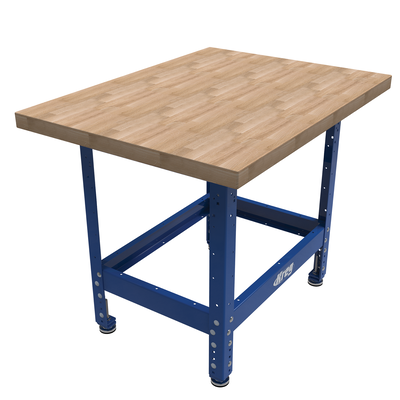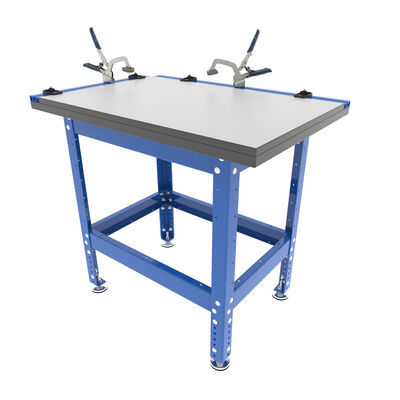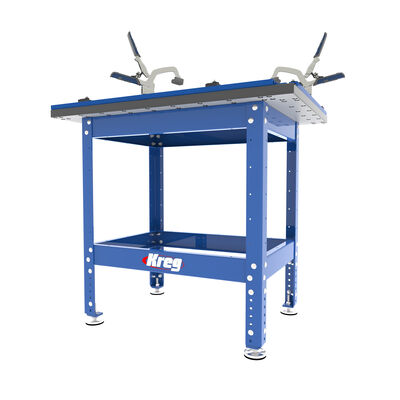Woodworking Benches 101
A high-quality workbench is one of the most crucial pieces of equipment when setting up a woodworking space. The workbench is the cornerstone of your workshop and where you'll spend most of your time. Therefore, it's crucial to pick on that meets your needs.
Woodworking Bench Must Haves
An essential component of a woodworking bench is a solid top. This top should be constructed from a durable material like composite, steel, or hardwood. This offers a level and solid surface for working. The top can support greater weight the thicker it is, which is great for bigger projects. In addition, a woodworking bench should have a sturdy base to give you a stable work surface and allow you to clamp objects firmly to the bench. Finally, you should consider the storage possibilities offered by your workbench. It’s always nice to have a shelf or drawers built in for storing your supplies and equipment. This helps you keep your workshop organized and makes it easy to find the tools you need when you need them.
Woodworking Bench Dimensions
A good size for a woodworking bench is typically four feet long and two feed wide. Without taking up too much space in your workshop, this provides you a reasonable amount of workspace. If you workshop is larger, you can choose a bench that is bigger as well, but it's a good rule of thumb to keep it proportionate to the size of your workshop.
How Tall Should a Woodworking Bench Be?
The ideal height for a woodworking bench is between 34 and 36 inches tall. Working at the bench is comfortable at this height, whether you're seated or standing. Since you'll likely be at your bench for a long period, it's crucial to pick a height that suits you.
Create the Bench That Fits You and Your Space
By combining legs and rails, you can create a customized workbench, tool stand, outfeed table, or assembly stand in 15 possible sizes - from 14" x 14" up to 64" x 64" - and two different adjustable heights, to fit your space, your projects, and your needs.
For Example
Let's say you want a custom woodworking bench, and you've decided it needs to be 2-foot by 4-foot and 31" tall to fit you space and project needs. First choose a set of tall legs. They're adjustable anywhere between 29" and 35". Next, choose your width by adding one set of 44" rails. Then, choose your depth with one set of 20" rails. Make a 2-foot by 4-foot top, and you'll have the exact bench you want.
Maybe you need a tool stand that's small but sturdy. You could choose one set of tall legs, one set of 14" rails for the width, and another set of 14" rails for the depth. You'll end up with 14" x 14" stand that adjusts from 29" to 35" tall. Add a set of optional casters, and you can make your tool stand mobile.
How Thick Should a Woodworking Bench Top Be?
A woodworking bench top should have a minimum thickness of two inches. For larger projects, a thicker top is better because it is more stable and can support more weight. A thicker top will be more durable and offer a flat, sturdy surface for working on. It's crucial to get a bench top that is strong and resilient so that it can resist the wear and tear of daily use.
How To Choose a Workbench
There are a few important factors to think about when selecting a workstation for your woodworking and DIY projects. These include the bench's dimensions, construction, and features, as well as your individual requirements and preferences. First and foremost, the workbench's size is crucial. You should make sure that it is big enough to hold your projects while not taking up too much room in your workshop. the workbench's material should be considered as well. Steel, wood, and composite materials are typical building materials.
What Should I Look for In a Woodworking Bench?
When it comes to features, look for a bench with a solid top and a sturdy base that can support a lot of weight. Drawers and storage options can also be useful for keeping your tools and materials organized. Finally, think about your specific needs as a woodworker. Do you need a bench that is portable and easy to move around, or one that is heavy and study enough to handle large projects? Are you a professional who needs a bench with a lot of storage, or a DIYer who just needs a basic surface to work on? By considering these factors, you'll be able to choose the perfect workbench for your woodworking projects.
Should You Build or Buy a Workbench?
Whether you should build or buy a workbench really depends on your specific needs and preferences as a woodworker. Buying a pre-made workbench may be the best first option. You'll have a sturdy, reliable surface to work on immediately without having to worry about building it yourself. If you're an experienced woodworker, you may want to create a custom workbench tailored to your specific needs. This way, you'll have complete control over the size and design used to create the perfect workbench for your projects.







